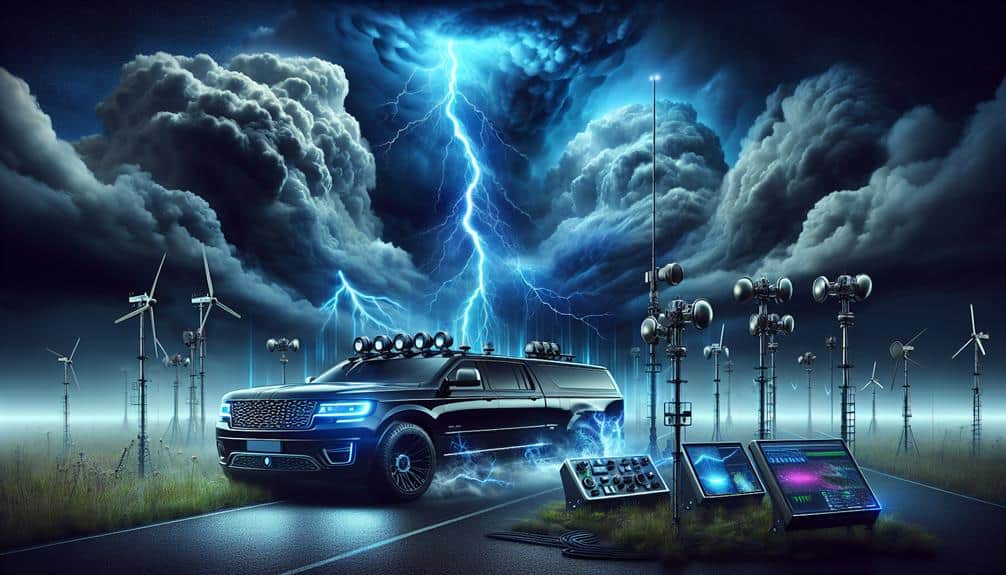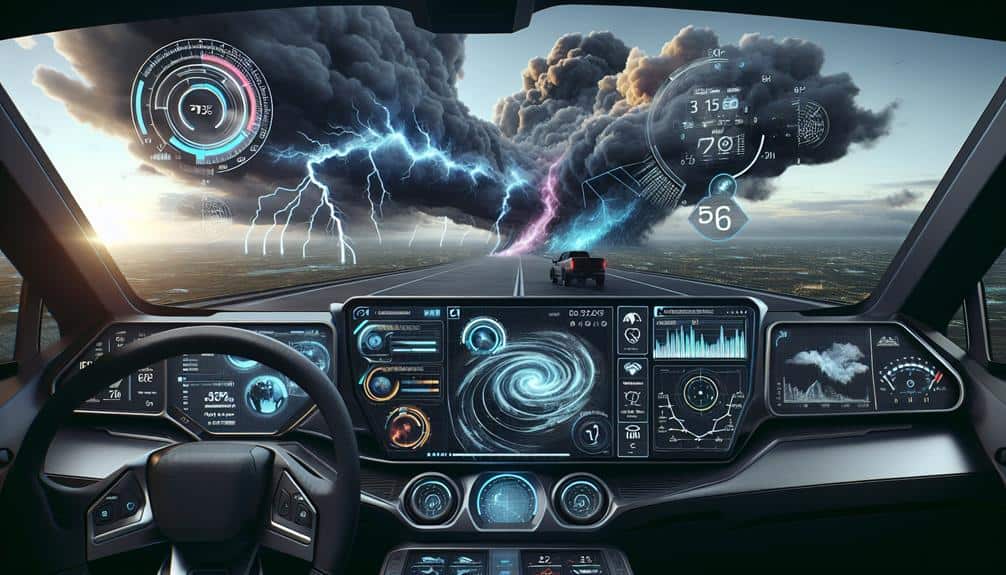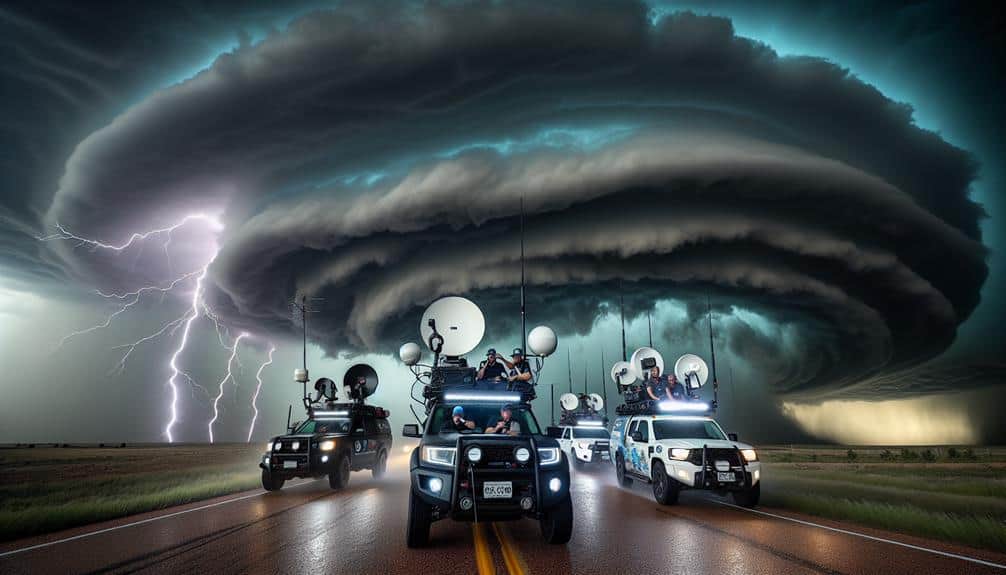When intercepting severe thunderstorms with vehicles, we must prioritize sturdy vehicle selection, equip ourselves with advanced weather monitoring tools, and always adhere to safety and communication protocols. High ground clearance and four-wheel drive are essential. We rely on analyzing meteorological data and satellite imagery to predict storm patterns accurately. Safety measures, including high-visibility markings and GPS trackers, are critical. Continuous real-time data sharing and dynamic route planning based on weather updates guarantee our efficiency. Collaborating with other chasers enhances our strategic approach and documentation of each mission provides valuable insights. Explore further to master these techniques.
Key Points
- Choose a vehicle with high ground clearance and four-wheel drive for better maneuverability in challenging terrains.
- Equip the vehicle with advanced weather monitoring devices and comprehensive emergency survival kits.
- Continuously analyze meteorological data, including wind shear, instability, and humidity levels, for accurate storm prediction.
- Ensure high-visibility markings, emergency kits, and GPS trackers are always operational for safety and navigation.
Choosing the Right Vehicle
Choosing the finest vehicle for intercepting severe thunderstorms necessitates a thorough analysis of durability, maneuverability, and specialized equipment compatibility. When we delve into vehicle selection, our main focus is on safety features and weather preparedness.
Data indicates that vehicles with reinforced frames and high ground clearance are more suitable to navigate through flooded areas and debris-strewn roads. Additionally, four-wheel drive capabilities enhance maneuverability, allowing us to maintain control under adverse conditions.
Safety features can't be underestimated. Modern vehicles equipped with advanced stability control systems, anti-lock brakes, and sturdy airbags offer a higher degree of protection. Our vehicle selection process also examines the vehicle's ability to integrate essential weather instrumentation, ensuring smooth compatibility with our equipment checklist. Models that provide sufficient space for mounting radar, communication devices, and GPS units are prioritized.
Weather preparedness encompasses more than just the vehicle's build; it includes readiness for rapidly changing conditions. Vehicles with exceptional ventilation systems help maintain visibility, while durable, all-weather tires contribute to reliable traction. Assessing these technical specifications guarantees we're not only ready to intercept severe thunderstorms but also maintain the liberty to navigate safely and efficiently.
Essential Equipment to Carry
We must equip our vehicle with advanced weather monitoring devices to provide real-time data on storm developments.
Additionally, carrying a thorough emergency survival kit guarantees we're prepared for any unforeseen circumstances.
These tools are critical for both safety and effective storm tracking.
Weather Monitoring Devices
For accurate storm analysis, advanced weather monitoring devices such as anemometers, barometers, and Doppler radar units are essential equipment to carry. These tools provide us with precise data necessary for real-time decision-making during storm chasing.
Anemometers measure wind speed, allowing us to gauge the storm's intensity and predict potential hazards. Barometers track atmospheric pressure changes, offering insights into storm formation and development.
Using a portable Doppler radar unit, we can visualize storm structures and identify rotating updrafts that may indicate tornado formation. This advanced weather radar technology helps us stay ahead of the storm's path, ensuring we position ourselves strategically.
By combining data from these devices, we can create a detailed storm profile, enhancing our ability to predict severe weather events.
Moreover, integrating GPS systems with our weather monitoring devices enables us to map storm trajectories accurately. This synchronization allows for seamless navigation and efficient resource deployment.
In storm chasing, every second counts, and having reliable, data-driven tools at our disposal empowers us to make quick, informed decisions. By leveraging these technologies, we maximize our ability to intercept severe thunderstorms safely and effectively, embracing the freedom that comes with mastering the elements.
Emergency Survival Kit
Equipping ourselves with a thorough emergency survival kit is crucial to ensuring safety and preparedness during severe thunderstorm intercepts. Our kit should include non-perishable food supplies, such as energy bars and canned goods, sufficient for at least 72 hours. Hydration is equally important, so pack enough water to cover the same period, aiming for one gallon per person per day.
A detailed first aid kit is non-negotiable. It must contain adhesive bandages, antiseptic wipes, gauze pads, medical tape, and a variety of medications including pain relievers and antihistamines. We should also include specialized items like tweezers, scissors, and a CPR face shield.
Regarding shelter and clothing, we need to be prepared for the worst. A durable, waterproof tent or tarp can provide essential protection from the elements. Additionally, thermal blankets and extra layers of clothing, including waterproof jackets and sturdy boots, are essential. Aim for materials that are both breathable and insulating.
Analyzing the risks, it's clear that a well-assembled emergency survival kit can mean the difference between life and death. By systematically addressing our needs for food supplies, first aid, shelter, and clothing, we greatly enhance our resilience against the unpredictable nature of severe thunderstorms.
Understanding Weather Patterns

Accurately predicting severe thunderstorms requires a deep analysis of meteorological data and an understanding of atmospheric dynamics. To effectively engage in storm tracking, we must scrutinize a variety of atmospheric conditions. This involves interpreting satellite imagery, Doppler radar data, and surface weather observations.
Understanding weather patterns is paramount. We analyze pressure systems, temperature gradients, and humidity levels to predict the formation and movement of severe thunderstorms. By doing so, we can enhance our ability to anticipate potential storm development zones.
Key factors include:
- Shear and Instability: Wind shear and atmospheric instability are critical in determining the storm's severity and potential for tornadoes.
- Dew Point: High dew points indicate moisture-rich air, which can fuel storm development.
- Lifted Index (LI): A negative LI value points to a highly unstable atmosphere, conducive to severe thunderstorms.
Safety Precautions to Follow
To ensure our safety while intercepting severe thunderstorms, we must adhere to strict protocols and continually monitor real-time data. Our first step involves conducting a thorough risk assessment, analyzing weather models, radar data, and satellite imagery to anticipate storm trajectories and intensities.
We need to equip our vehicles with necessary safety gear, such as high-visibility markings, emergency kits, and GPS trackers. Safety protocols dictate that we maintain a minimum distance from the storm's core to avoid hazards like hail, strong winds, and tornadoes. We should always have multiple escape routes planned, ensuring swift evacuation if conditions deteriorate.
Our vehicles must be in top condition, with regular maintenance checks focusing on tires, brakes, and fuel levels. Emergency response readiness is essential. We need to prepare for potential scenarios such as vehicle breakdowns or injuries. This includes carrying first aid supplies, communication devices, and backup power sources.
Our communication strategies must be strong, enabling constant contact with team members and local emergency services. Real-time updates via mobile apps and weather radios will keep us informed of any sudden changes.
Communication Strategies

Effective communication strategies are essential for coordinating our team and guaranteeing real-time information flow during severe thunderstorm intercepts. We rely on precise, timely exchanges to adapt to rapidly changing weather conditions and to maintain safety. Communication etiquette is foundational—each member must adhere to established protocols to minimize confusion and guarantee clarity.
Leveraging technology is crucial. We use high-frequency radios, mobile apps, and satellite communication to stay interconnected. Data-driven decisions are only as good as the information shared, so we emphasize the importance of continuous updates. This fosters seamless team coordination and optimized decision-making.
- Standardized Protocols: Establish clear, concise communication protocols, including specific terminology and predefined signals.
- Redundancy Systems: Employ multiple communication channels to guarantee backup options are available if primary systems fail.
- Regular Check-Ins: Schedule routine check-ins at predetermined intervals to confirm the status and location of all team members.
Our navigation and route planning depend on real-time meteorological data and sophisticated modeling software to strategically position our vehicles for the best storm intercepts. By integrating high-resolution weather updates, we can dynamically adjust our route optimization strategies to maximize efficiency and safety. Utilizing GPS and Geographic Information Systems (GIS), we overlay storm trajectories on detailed maps, allowing us to predict and avoid potential hazards.
Given the unpredictable nature of severe weather, our approach includes constant assessment of emergency response protocols. We account for road closures and detours in real-time, ensuring that our planned routes remain viable under rapidly changing conditions. This adaptability is essential for maintaining mobility and access to key observation points.
Our team leverages machine learning algorithms to analyze historical storm data, enhancing our predictive capabilities. These insights inform our decision-making processes, allowing us to preemptively identify the best intercept locations. By continuously monitoring meteorological data and adjusting our routes accordingly, we remain agile and responsive to emergent threats.
Real-Time Data Monitoring

Building on our optimized navigation strategies, real-time data monitoring becomes paramount to track storm developments and adjust our intercept plans instantaneously. Leveraging advancements in technology, we can enhance data accuracy and precision, guaranteeing our decisions are data-driven and timely.
The integration of storm tracking systems with GPS technology allows us to maintain an up-to-the-minute understanding of storm dynamics. We can utilize high-resolution radar data, satellite imagery, and real-time weather updates to identify the storm's movement and intensity. This continuous data influx empowers us to make informed navigational adjustments, optimizing our path to intercept the storm safely and effectively.
Key components of our real-time data monitoring strategy include:
- High-Resolution Radar Data: Provides detailed insights into storm structure and movement, critical for making quick decisions on the go.
- Satellite Imagery: Offers a broader view of weather systems, helping us anticipate changes in storm behavior.
- Mobile Weather Stations: Collect local atmospheric data in real time, enhancing our situational awareness.
Maintaining Vehicle Readiness
Ensuring our vehicles are in peak operational condition is vital for the successful interception of severe thunderstorms. Thorough vehicle maintenance is non-negotiable. Regular checks on engine oil, brake fluids, and tire integrity are essential for reliable performance under stress. A detailed readiness check before each chase is obligatory. This includes confirming that the battery is fully charged, the fuel tank is full, and windshield wipers are functional. Our ability to move swiftly and safely can make the difference between a successful intercept and a hazardous situation.
Equipping our vehicles with appropriate safety gear enhances our emergency preparedness. A well-stocked emergency kit should include first-aid supplies, flashlights, batteries, and a multi-tool. Additionally, a heavy-duty jack, spare tire, and jump cables are essential. These items ensure that minor mechanical issues don't escalate into major problems, keeping us on the road and in the hunt.
Data-driven analysis shows that well-maintained vehicles are 40% less likely to experience breakdowns during severe weather conditions. Keeping detailed records of vehicle maintenance and readiness checks can help identify patterns and preemptively address potential issues. Remember, our freedom to chase comes from our commitment to preparedness and maintenance.
Collaborating With Other Chasers

Effective collaboration with other chasers boosts our ability to gather thorough data and secure safety during severe thunderstorms. By leveraging team coordination and adhering to stringent safety protocols, we can optimize our data collection efforts while minimizing risks.
The foundation of effective collaboration lies in robust communication and precise location tracking, ensuring all team members are synchronized and aware of each other's positions.
To achieve seamless cooperation, we employ the following strategies:
- Real-time communication: Utilize radio systems and messaging apps to maintain constant contact, providing updates on storm developments and any changes in plans.
- Location tracking technologies: Implement GPS devices and tracking software to monitor each vehicle's location, facilitating coordinated movements and reducing the likelihood of accidents.
- Predefined safety protocols: Establish clear guidelines for safe distances, escape routes, and emergency procedures to secure everyone's well-being during high-risk situations.
Documenting Your Experience
Capturing our storm-chasing experiences demands meticulous documentation through high-resolution photographs, detailed field notes, and thorough video recordings. Effective equipment organization is vital. We must make sure our cameras, lenses, tripods, and data storage devices are readily accessible and protected from the elements.
To optimize data collection, we should use GPS-enabled devices that automatically geotag our photos and videos, providing precise location data critical for post-analysis.
For video documentation, high-frame-rate cameras help capture the rapid dynamics of storm systems. Stabilized mounts in our vehicles guarantee smooth footage despite rough driving conditions. Employing wide-angle lenses allows us to encompass the vast scale of thunderstorms, while zoom lenses can focus on specific features such as funnel clouds or lightning strikes.
Photography tips include using a low ISO setting to minimize noise and a fast shutter speed to freeze motion. Bracketing exposures can capture the high contrast between storm clouds and lightning. Detailed field notes should complement our visual data, logging time, location, weather conditions, and any notable observations.
Frequently Asked Questions
What Should I Do if I Encounter Flash Flooding While Chasing a Storm?
If we encounter flash flooding while chasing a storm, our flood escape strategy should prioritize immediate retreat to higher ground. Safety precautions include avoiding flooded roadways and monitoring real-time data to guarantee we maintain situational awareness.
How Can I Identify a Safe Place to Take Shelter if Conditions Worsen?
Like Odysseus seeking refuge from Poseidon's wrath, we must evaluate shelter options and safety precautions. Our emergency preparedness and risk assessment should direct us to sturdy buildings, avoiding underpasses or isolated areas where flash flooding poses risks.
What Are the Best Apps for Tracking Severe Weather in Real-Time?
For real-time tracking, we recommend apps like RadarScope and MyRadar. They provide detailed weather radar data and timely storm alerts, helping us make informed decisions and maintain our freedom to navigate safely during severe weather events.
How Can I Ensure My Insurance Covers Storm Chasing Activities?
To confirm our insurance covers storm chasing activities, we should start by reviewing policy details and discussing storm preparedness with our provider. This analytical approach verifies data-driven coverage specifics, granting us the freedom to chase storms confidently.
What Steps Should I Take if My Vehicle Gets Damaged During a Chase?
If our vehicle gets damaged during a chase, we should promptly assess repair options and file insurance claims. Ensuring equipment maintenance and adhering to safety precautions will help minimize future damage and maintain operational freedom.


